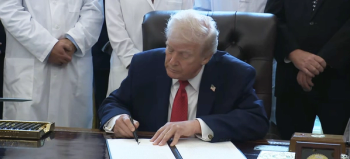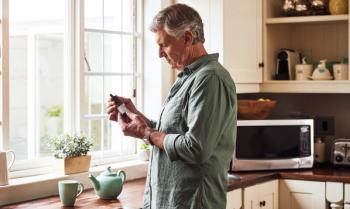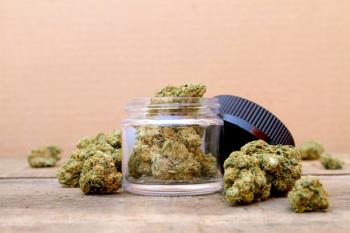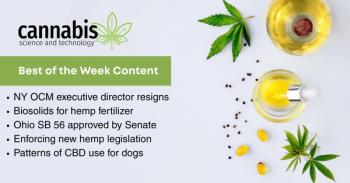
Cannabis Science and Technology
- July/August 2024
- Volume 7
- Issue 4
- Pages: 28-31
Cannabis Packaging 101: Sustainable Innovations and Challenges
In this interview, Raphael Wechsler, Founder of Wroots Botanicals LLC, Sustainability Lead for Studio Voltaire LLC, and former Director of Partnerships and Operations and Sustainability Committee Chair for the Cannabis Association of New York, discusses the challenges of cannabis packaging and its sustainability in the industry.
When it comes to packaging, there are several variables that need to be considered. Some of these points to take note of are cost, safety, and if it's environmentally friendly. All these things play a role in the sustainability of packaging. In this interview, Raphael Wechsler, Founder of Wroots Botanicals LLC, Sustainability Lead for Studio Voltaire LLC, and former Director of Partnerships and Operations and Sustainability Committee Chair for the Cannabis Association of New York, discusses the challenges of cannabis packaging and its sustainability in the industry.
How does your experience and education give you a unique understanding of cannabis packaging and sustainability?
Raphael Wechsler: I have unique views on this subject because I have served in different roles whereby I have gained perspectives from business and brand owners, cultivators, academics, policy and regulatory, and consumer perspectives. Additionally, even though it may sound completely irrelevant, working in corporate finance in Iceland or technology with Apple, you gain a broad knowledge, experience, and perspective capability to see things through different lenses. Every dimension needs to be considered and the more diverse your experience is, the greater the vantage points, and—very importantly—the more you can understand what drives decision making in each universe. From an evidence-based decision-making model, your dataset is more expansive, and you are exposed to more ideas at the margin. These may seem nonsensical today, but if they are given the respect they deserve, in time they can be game changers—I’ll dive into some of these later.
What are some regulations and standards for cannabis packaging?
Wechsler: First and foremost, packaging regulations are designed around the intent of serving the public with such aspects including labeling that is clear, details about cannabinoid content such as tetrahydrocannabinol (THC) or cannabidiol (CBD) in grams per serving, warnings such as the impairment of driving ability with consumption, and labeling that does not entice children. For example, a brand cannot create images or artwork on a mylar bag for edibles making it look like it belongs in a drug store candy section. Another example, and I have some unique views on this, but if we look at regulations in the NortheastUS, all packaging for any product with THC/A must be child resistant.
What are the main elements of sustainable cannabis packaging?
Wechsler: Sustainable cannabis packaging, to me, is domestically or locally sourced, designed and made by a company that itself is sustainable and treats its employees well with sustainable incentives, is made from materials that have a traceable audit with public results, has a low packaging weight to contents ratio, obviously is nontoxic, in most cases is child-resistant, and has a clear way to either reuse or ensure true recyclability.
What are some current and upcoming innovations in cannabis packaging?
Wechsler: I must be transparent in terms of my model for ideal packaging: a banana peel, an orange peel, or, put differently, how nature packages. The beginning and end of life are where I start because like most packaging, the product is quickly consumed but the packaging and impact remain. Having said this, the innovations that excite me the most are non-petroleum based, or created without great waste whether it be plastic, glass, or metal. Specifically, carbon-based packaging built by materials that are grown rather than extracted and manufactured, is the ideal. Examples include hemp, hemp-based polymers, polyhydroxyalkanoates (PHA), mycelium, seaweed, plastic captured from our oceans, and pulp from sustainably grown materials such as bamboo or wood. On top of that, and this is an area I am particularly passionate about, is in reusable packaging; because ultimately single use cannabis packaging is what we should all work to replace or ban. Ever eat at a restaurant? I’m pretty sure the glass you drank out of, the plate your food was on, and the silverware that put food in your mouth were all previously used by hundreds of people.
How sustainable is packaging in the cannabis/hemp industry currently?
Wechsler: As I read this question, I can’t help but think of the dedicated members of the sustainability committee I had the privilege to chair, their expressions ready to burst with ideas and insights. The short, hard, and tough pill to swallow is: in general, it is not [sustainable] and there are several real reasons for this. To start, let’s do some quick math. If we take one cannabis product in dried whole flower, which would include pre-rolls, and look at a developed market such as Massachusetts, together they account for about a 63% share of retail sales (1). If we take a common stock keeping unit (SKU) such as a 1/8 oz or 3.5 grams (an eighth) that comes in a virgin plastic polypropylene (PP) or high-density polyethylene (HDPE) dram jar made in China, that brings with it a slew of environmental problems:
a) Packaging Weight to Content Ratio: a plastic jar will on average weigh around 70 grams to store 3.5 grams of plant material.
b) Sourcing and Sustainability Standards: Being produced with little to no sustainability oversight in China and then shipped to the US is, no matter how you look at it, terrible for the environment.
c) Lifecycle: The cannabis product will likely be consumed somewhere between 1-5 days, but the plastic packaging will remain, for all intents and purposes, forever.
d) Recyclability: At this point, most consumers in the US assume that plastic is not only recyclable, but recycled regardless of size, color, or object. The reality is around 90% of plastic is NOT recycled and ends up all around and now inside of us (2). If I were to hold up a black HDPE or PP dried flower jar and ask 100 consumers in Massachusetts or New York if that packaging is recycled in their state, I am willing to wager at least 50% believe it is. But the reality is that at most Material Recovery/Recycling Facilities (MRFs or ‘merfs’) the infrared scanners that identify and sort cannot detect black, so it goes to landfill.
Loyalty as a double-edged sword: If a consumer finds a cannabis brand that they love, for many they soon overlook the waste associated, thus ensuring future demand and creation of more single use packaging waste. But this problem is also one of the biggest opportunities. I wish everyone in the cannabis industry printed this in their offices because if they did, and truly understood this, they could help change the world (3): “According to Deloitte, Gen Z is adopting more sustainable behaviors than any other group: 45% stopped purchasing certain brands because of sustainability or ethics concerns.”
What are some challenges and solutions to sustainable packaging?
Wechsler: If I could fix a few problems, the priority list might look like this:
- Education of both consumers and business owners: While working on sustainability initiatives at a packaging company and with a large trade association, I spoke with hundreds of brand owners. I would say 90% wanted to be sustainable, but when the conversation shifted to the ‘how’, the response will often sound like this: “I can get Mylar bags for around 11 to 12 cents, depending on the quantity. But going biodegradable often increases that cost anywhere from 10 to 15 cents apiece.” On the one hand this is their economic reality and I get that. At the same time, let’s be real, and not use that as a convenient way to make the easy, self-serving choice. What they either do not know, or are unwilling to invest in to achieve, is that studies have shown that consumers will pay a meaningful premium, as in over 25% more, for sustainable products and according to a New York University (NYU) study, grow at 2x the rate of those that are not (4).
- Brass tacks: Let’s get deeper into perhaps the largest impediment to a marketplace filled with sustainable packaging. The number of conversations I’ve had with companies that started all “sustainable this” and “eco-friendly that” were fine until they see the increased "cost" is well over 100x. I can tell you specifically that the price insensitivity level for sustainable packaging is right around the 15-20% threshold. If 45% of Gen Z consumers—as in 31 million—will drop you completely when they find you are not committed to saving the planet, in what world is increasing your packaging cost by 30% not worth it?
- Frictionless recycling and reusability: Consumers need to have an economic incentive to not only choose products with sustainable packaging, but also it must be easy to do so. For example—and I am very proud of the regulatory work we did at Cannabis Association of New York (CANY) with our sustainability committee—every New York dispensary can have a loyalty program built around sustainable packaging and reusability.
What steps would a cannabis company need to take to implement more sustainable packaging for their products?
Wechsler: Make sustainability an integral part of your mission and DNA…full stop. Very simple, have sustainability focused positions that are involved top to bottom in decision making, local or domestic sourcing unless there is a valid sustainability reason for international sourcing, conducting lifecycle assessment (LCAs) on vendors and supply chain, having an internal sustainability plan with radical and public transparency, prioritizing non-petroleum materials with a benign beginning and end of life, and lastly, a campaign to help brands showcase their sustainable packaging with impact case studies to motivate other companies.
Would rescheduling or descheduling of cannabis affect cannabis packaging?
Wechsler: The short answer is yes. This may be unpopular, but I believe a key solution to making cannabis packaging more sustainable and increase both recyclability and reusability is some standardization in a bottle/packaging bill. Look at Maine, Vermont, and Connecticut or other states that have some sort of bottle bill with standardization. States with bottle bills have a beverage container recycling rate of around 60%,while non-deposit states only approach about 24% (5). Standardization will make it easier for MRFs to invest in state-of-the-art sorting machines or new technologies so less get spat out to a landfill where a lot of glass ends up. With rescheduling, cannabis will become normalized just like beer, and with that, bring more sustainable packaging options.
Do you have any advice/recommendations for both beginner and advanced cannabis manufacturers who specialize in packaging?
Wechsler: First and foremost, my advice is to prioritize offering only truly sustainable packaging solutions. No plan B! Second, no matter how appealing it may be short term, do not greenwash in any way. For example, and this is why it is important to have an in-house sustainability subject matter expert, you might see a company offer plastic jars or pre roll tubes with a claim that they are ‘biodegradable’. When you see this your antennae should stand right up. Passing ASTM D5511, for example, is not the solution nor in my view a sustainable solution. Third, focus on either licensing, funding, or developing in-house proprietary packaging solutions with raw materials that are grown organically or without the use of malignant chemicals. Fourth, build solutions around reusable packaging and if that is not possible, focus on materials that have high capture rates in the MRFs, such as aluminum.
I have a friend who used to be the #1 salesperson for a cannabis packaging company. When we met, he was filled with passion for sustainability but, over time, that changed and one day—with great frustration—he said, “we sell trash.” Not surprisingly that person left. When you do good work and truly commit to being a sustainable company that is not focused on today’s profit margins, something amazing happens. Your employees develop a sense of pride in working for you, in doing good work themselves, and then they tell everyone they know. When a packaging company is focused on making money for its owners first, that is one of the purest forms of not being sustainable that I know of, and it is a matter of time before employees and consumers catch on.
In closing, I have great faith in North American and European consumers who are, more than ever, demanding that the products that they purchase and put into their bodies are made sustainably, with natural ingredients, by companies that give back, prove their positive environmental impact, and finally care more about our fragile world more than their wallets. The most important force in the world to me is the United States consumer. Every waking day a company has a choice in whether to create sustainable goods and solutions people will love or wait for the market to force the issue. All I know is…leaders go first.
References
- Retail sales share of recreational cannabis in Massachusetts as of May 2024, by segment. Statista.
https://www.statista.com/statistics/1469982/massachusetts-marijuana-retail-sales-share-by-product/#:~:text=Flower%20made%20up%20a%20nearly,of%20roughly%2018.6%20percent%20each (accessed July 29, 2024). - A whopping 91 percent of plastic isn’t recycled
https://education.nationalgeographic.org/resource/whopping-91-percent-plastic-isnt-recycled/ (accessed Jul 29, 2024). - Deloitte’s 2024 gen Z and millennial survey finds these generations stay true to their values as they navigate a rapidly changing world
https://www2.deloitte.com/cn/en/pages/about-deloitte/articles/deloitte-2024-gen-z-and-millennial-survey.html (accessed Jul 29, 2024). - Kronthal-Sacco, R.; Whelan, T.; Sustainable Market Share Index™ 2021 Report, 2022, NYU Stern.
https://www.stern.nyu.edu/sites/default/files/assets/documents/FINAL%202021%20CSB%20Practice%20Forum%20website_0.pdf (accessed Jul 29, 2024). - Beverage Container Deposit legislation
https://www.rila.org/retail-compliance-center/beverage-container-deposit-legislation (accessed Jul 29, 2024).
About the Authors
Madeline Colli is the Editor for Cannabis Science and Technology magazine. Direct correspondence to:
Erin McEvoy is the Assistant Editor for Cannabis Science and Technology magazine. Direct correspondence to:
To reach Raphael Wechsler, direct correspondence to:
How to Cite this Article
Wechsler, R., Cannabis Packaging 101: Sustainable Innovations and Challenges, Cannabis Science and Technology, 2024, 7(4), 28-31.
Articles in this issue
over 1 year ago
Calibration Science, Part V: Spotting Outliersover 1 year ago
Lighting Penetration in Indoor Cannabis CultivationNewsletter
Unlock the latest breakthroughs in cannabis science—subscribe now to get expert insights, research, and industry updates delivered to your inbox.




